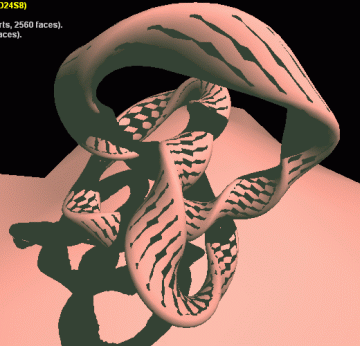Reverse extruded shadow volumes
My colleague Renaldas Zioma aka ReJ (email) came up with this idea. So far we don't know of anyone else who have used it before. Extended version can be found in ShaderX2 book.
The technique
Suppose that for some reason we want to use stenciled shadow volumes and don't want to use CPU to find silhouette edges - we want static geometry and a vertex shader. We also want self-shadowing, but don't want to use high-poly mesh for shadow volume. Eg.: a mesh and a simplified mesh:

Conventional shadow volume is built by extruding back-facing vertices away from light source: check the angle between light and a normal and either extrude away or leave vertex in place.
Reverse extruded shadow volume is built by extruding front-facing vertices - leave back-facing ones in place, but send away from light the ones that face the light.
Illustrated: in the "normal" case the marked vertices are extruded, and the rest left in place. We get a shadow volume that covers both the object and a shadow space behind it. In "reverse" case, we extrude the marked vertices, and get a shadow volume that covers only the shadow space behind the object.

Conventional extrusion may cause problems when simplified mesh is used - either you have to manually fatten or shrink the volume, push frontfaces backwards a bit, or disable self-shadowing. Illustrated:

The self-shadowing artifacts on the lit side are caused by the simplified mesh - it's protruding from the original mesh in these places.
If we reverse the extrusion, the artifacts are gone - the frontfacing vertices are pushed back, so there's nothing to protrude. Illustrated:

What we lose by reversing the extrusion are direct shadows on the backside of the object. But these can be dealt with the shading system - "no light" is nearly the same as "in shadow". In the picture some artifacts can be seen - it's because per-vertex lighting is used there, not per-pixel.
We've used this "reverse" technique in our game on skinned characters (mesh ~8000 vertices, simplified mesh ~2000 vertices) and so far it worked well.
Demo
A small demo illustrating all this (normal vs. reverse extrusion, high vs. low poly shadow mesh). Requires DirectX 8.1 and stencil buffer support.
Binary and source here (394 KB).
The extrusion here is performed with a vertex shader (all the other transformations also). Geometry isn't "prepared well" for shadow volumes - there are no thin polygons between real polygons. But the idea is illustrated :)